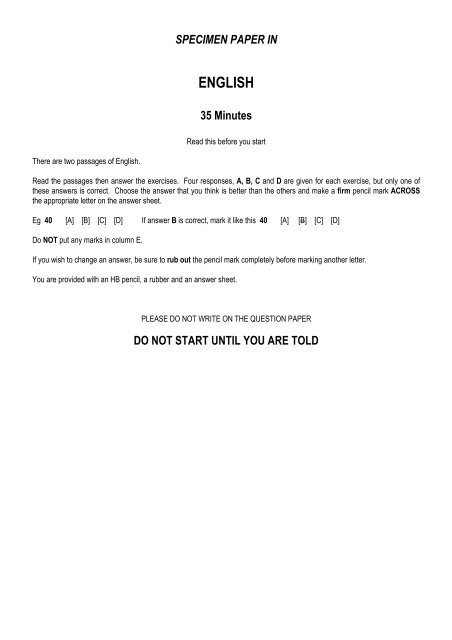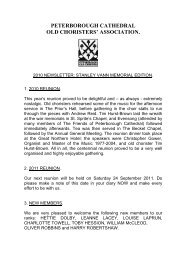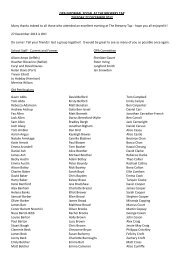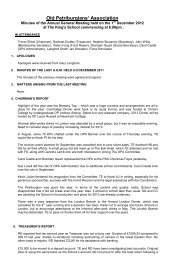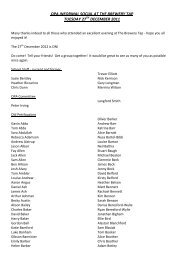You also want an ePaper? Increase the reach of your titles
YUMPU automatically turns print PDFs into web optimized ePapers that Google loves.
SPECIMEN PAPER IN<br />
ENGLISH<br />
35 Minutes<br />
Read this before you start<br />
There are two passages of <strong>English</strong>.<br />
Read the passages then answer the exercises. Four responses, A, B, C and D are given for each exercise, but only one of<br />
these answers is correct. Choose the answer that you think is better than the others and make a firm pencil mark ACROSS<br />
the appropriate letter on the answer sheet.<br />
Eg 40 [A] [B] [C] [D] If answer B is correct, mark it like this 40 [A] [B] [C] [D]<br />
Do NOT put any marks in column E.<br />
If you wish to change an answer, be sure to rub out the pencil mark completely before marking another letter.<br />
You are provided with an HB pencil, a rubber and an answer sheet.<br />
PLEASE DO NOT WRITE ON THE QUESTION PAPER<br />
DO NOT START UNTIL YOU ARE TOLD
Passage 1<br />
Timur the Great Lame Man<br />
10<br />
20<br />
30<br />
40<br />
‘Everything I have heard about the beauty of Samarkand is correct, but actually it is more<br />
beautiful than I had imagined.’<br />
These are the words of Alexander the Great when first he saw this ancient capital of<br />
Asia on his march to India in the fourth century before Christ.<br />
Samarkand is in Central Asia, is over 2,500 years old, and has been called ‘the gem<br />
of the world’, ‘the shining point of the globe’, and ‘the city of famous shadows’. It has seen<br />
many conquerors like Alexander because of its beauty and its position on the Silk Road.<br />
This road was 8,000 miles long and ran from Spain to China. It was used by vast caravans<br />
to bring back silk and spices from China in return for silver and gold.<br />
One of the most terrible of Samarkand’s conquerors was Tamerlane or Timur the<br />
Great Lame Man (1370-1405). He was a Turkish warlord who gathered men from all over<br />
Asia into one vast army with which he sacked most of Asia’s cities and towns. He chose<br />
Samarkand as his capital and brought in artists and workmen who were given the job of<br />
making it the most beautiful city in the world.<br />
Fabulous treasures were taken to the city and magnificent palaces, mosques and<br />
tombs were built. One of the great surviving buildings of Timur’s reign is the majestic Gur-<br />
Emir Mausoleum. Timur built it as a tomb for his grandson the Mukhammed-Sultan, who<br />
died on a march to Turkey in 1403. The blue fluted dome of the tomb gleams amid the<br />
trees. Its walls are decorated with mosaics in different shades of blue, and the entrance is<br />
painted in white, green, blue, yellow, black and gold. The inside of the dome rivals the<br />
outside in its beauty and blue colour scheme. Beneath it lie the tombs of Timur, his sons<br />
and grandsons. Timur’s skeleton rests under a great slab of dark-green jade behind a<br />
marble railing.<br />
The graves of Timur and his family were untouched for over five hundred years until,<br />
in 1941, they were looked at by scientists. According to legend Timur was<br />
called the ‘great lame man’, and the watchers waited to see if the legend was true. When the<br />
last shovel of earth was removed from the grave a wooden coffin could be seen. It was in<br />
good condition even though the nails had rusted away. When the boards of the lid were<br />
lifted the skeleton of Timur was revealed for the first time and everyone crowded forward.<br />
There were no weapons or armour of any kind in the coffin. All eyes were now on the<br />
skeleton, quickly checking the bones of each leg.<br />
Sure enough, one leg was shorter than the other. Timur had really been lame and the<br />
ancient manuscripts had spoken the truth.<br />
Timur’s favourite wife, Bibi-Khanym, was not buried with her husband. For<br />
her Timur had built what was then the largest mosque in the Islamic world. Of it was<br />
said that ‘its dome would have been the only one in the universe, had not the sky been<br />
its replica, and its arch would have been unique had not the Milky Way been its<br />
match’. Unfortunately, the mosque was almost completely destroyed by an earthquake<br />
several centuries ago, but the majestic ruins that still rise above the city like golden<br />
rocks manage to give a hint of its former glory.<br />
It seems that the artists and workmen brought to Samarkand by Timur were<br />
fascinated by the vivid blueness of its sky. They took the colour and repeated it in<br />
every building so that it shines on the tall stems of the minarets and on the huge domes<br />
of the mosques. These unknown workmen created a rhapsody in blue which the world has<br />
admired for the last five hundred years.<br />
Reginald Hutchinson<br />
We are indebted to Longman Group (UK) Ltd for permission to reproduce this passage which is from Longman<br />
<strong>English</strong> 2 by R B Heath & T M McSweeney<br />
TURN OVER FOR PASSAGE 2<br />
2
Passage 2<br />
A Greek Story<br />
This story was part of an advertisement for Greek holidays<br />
Clive and his wife were driving in southern Crete, trying to find their way to a particular<br />
mountain village. Hopelessly lost, they stopped and asked a Cretan the way.<br />
Typically he spoke some <strong>English</strong>.<br />
‘Straight up the road,’ he said. ‘It is a bad road but you can make it.’ They<br />
drove along the road for a few miles until they found the way blocked by a mountain of<br />
gravel. An old man standing on the gravel made circular motions with his hand, and<br />
Clive switched off the engine. The old man then leaped into a bulldozer and proceeded to carve<br />
a path through the gravel. Five minutes later he smilingly waved them through a billowing cloud<br />
of dust.<br />
10 Driving on a few miles more our adventurers once again found themselves hopelessly lost<br />
and decided to call it a day. Pulling in at the first small taverna in the<br />
next village they came to, they wearily slumped into chairs at the solitary table on a small terrace<br />
in front of the taverna, and a waiter appeared.<br />
‘Two Greek coffees, please,’ said Clive, and the waiter nodded and trotted off into the dim<br />
interior. Over coffee, Clive and his wife got down to the Greek national<br />
pastime of just sitting and watching the world go by, joined we might add, by the<br />
friendly waiter.<br />
A little later, Clive ordered two Rakis ( a potent Greek spirit), and being a<br />
generous soul bought the waiter a drink as well. Time rolled pleasantly on, as it<br />
20 usually does in Greece, and eventually Clive asked the waiter for the bill. ‘There is no charge,’<br />
he said.<br />
‘Oh,’ said Clive, ‘that’s very kind of you – do you own this taverna?’ ‘No,’ said the Greek,<br />
poker faced, ‘and this isn’t a taverna, it’s my house.’<br />
3
Questions 1- 25<br />
Read PASSAGE 1 then answer the questions. Four answers, A, B, C and D are given for each<br />
question, but only one of these answers is correct. Choose the answer that you think is better than the<br />
others and make a firm pencil mark ACROSS the appropriate letter on the answer sheet. If you wish to<br />
change an answer, carefully RUB OUT your wrong answer and mark the new one.<br />
1 Alexander believed that Samarkand was<br />
A as beautiful as he had heard<br />
B more beautiful than he had heard<br />
C exactly as people had described it<br />
D not quite as beautiful as he had heard<br />
2 Alexander first saw Samarkand<br />
A over 2500 years ago<br />
B in AD 1370<br />
C in the 4 th Century BC<br />
D we are not told in the passage<br />
3 Samarkand is in<br />
A India<br />
B Spain<br />
C China<br />
D Asia<br />
4 Two reasons for Samarkand seeing conquerors were<br />
A its silver and jade<br />
B its silk and spices<br />
C its beauty and its lack of defences<br />
D its beauty and its position on the Silk Road<br />
5 Tamerlane’s home country was<br />
A China<br />
B Spain<br />
C Turkey<br />
D we are not told in the passage<br />
6 Which of the following expressions is used in the passage to describe Samarkand?<br />
A a rhapsody in blue<br />
B the only one in the universe<br />
C the Milky Way<br />
D wonder of the East<br />
7 All of the following were built by Tamerlane EXCEPT<br />
A palaces<br />
B mosques<br />
C cathedrals<br />
D tombs<br />
8 Which of the following statements is untrue?<br />
A Timur is buried under a slab of dark-green jade<br />
B Timur is buried with his sons and grandsons<br />
C Timur is buried with his wife<br />
D Timur built the Gur-Emir Mausoleum as a tomb for his grandson<br />
9 When Tamerlane built the tomb he was<br />
A 35<br />
4
B 43<br />
C an old man<br />
D 33<br />
10 The inside of the tomb’s dome is<br />
A less beautiful than the outside<br />
B as beautiful as the outside<br />
C more beautiful than the outside<br />
D too dark to estimate its beauty<br />
11 The entrance to the tomb is painted in all of the following EXCEPT<br />
A red<br />
B green<br />
C yellow<br />
D blue<br />
12 Beneath the dome of the mausoleum lie the tombs of all of the following EXCEPT<br />
A Timur<br />
B his sons<br />
C his favourite wife<br />
D his grandsons<br />
13 When Timur’s coffin was opened, the skeleton was<br />
A in perfect condition except that its nails had worn away<br />
B in perfect condition except that someone had shortened the bones of one leg<br />
C in poor condition<br />
D in perfect condition<br />
14 We are certain that Tamerlane was lame because<br />
A his grandson wrote letters describing his limp<br />
B when his skeleton was found the bones of one leg were shorter than the other<br />
C ancient pictures show one leg shorter than the other<br />
D stories passed down from generation to generation mention this<br />
15 Which of the following is a woman?<br />
A Bibi-Khanym<br />
B Gur-Emir<br />
C Mukhammed-Sultan<br />
D Tamerlene<br />
16 The favourite colour of Samarkand’s artists was<br />
A gold<br />
B green<br />
C yellow<br />
D blue<br />
17 The mosque that Timur built for his favourite wife was<br />
A small but beautiful<br />
B the largest in the Islamic world<br />
C unfinished<br />
D large but plain<br />
18 ‘mosaics’ (line 20) means<br />
A designs made of small coloured stones or pieces of glass<br />
B wall-papers<br />
C special kinds of moss<br />
D wall hangings the colour of moss<br />
19 The word ‘replica’ (line 38) means<br />
5
A<br />
B<br />
C<br />
D<br />
replacement<br />
exact copy<br />
reflector<br />
reflection<br />
20 ‘legend’ (line 26) means<br />
A story from the past which may not be true<br />
B story from the past which is true<br />
C story from the past which is not true<br />
D ancient document<br />
21 The word ‘vivid’ (line 43) means<br />
A dark<br />
B bright<br />
C like a dome<br />
D brought by artists and workmen<br />
22 ‘minarets’ (line 44) are<br />
A strong columns<br />
B artificial flowers<br />
C small mines<br />
D thin towers in a mosque<br />
23 Which of the following is the correct spelling?<br />
A fascinated<br />
B fascanated<br />
C fascenated<br />
D fassinated<br />
24 Which of the following is the correct spelling?<br />
A skelleton<br />
B skelliton<br />
C skeleton<br />
D skelaton<br />
25 ‘unique’ (line 38) means<br />
A very rare<br />
B magnificent<br />
C one and one only<br />
D perhaps the only one<br />
6
Questions 26 to 35<br />
Read PASSAGE 2 then answer the questions. Four answers A, B, C and D are given for each question, but only one of these answers is<br />
correct. Choose the answer that you think is better than the others and make a firm pencil mark ACROSS the appropriate letter on the<br />
answer sheet. If you wish to change an answer, carefully RUB OUT your wrong answer and mark the new one.<br />
26 The person Clive and his wife stopped to ask the way<br />
A was accurate in his description of the road<br />
B misdirected them<br />
C underestimated the difficulty of the route<br />
D was unsure of the road’s suitability<br />
27 The old man’s circular movements of his hand meant<br />
A ‘Switch off your engine’<br />
B ‘Find another road’<br />
C ‘Go round the pile of gravel’<br />
D ‘Turn around and go back the way you came’<br />
28 The old man<br />
A worked at his usual pace to carve a path through the gravel<br />
B worked quickly but resentfully to carve a path<br />
C worked quickly and happily to carve a path<br />
D took a long time to carve a path<br />
29 Clive and his wife thought that they had found a taverna because they saw<br />
A the table and chairs on the terrace<br />
B the inn-sign<br />
C the waiter<br />
D the coffee<br />
30 According to the passage, the Greek national pastime is<br />
A drinking coffee<br />
B watching the world go by<br />
C going to a taverna<br />
D drinking Raki<br />
31 The man whose house Clive and his wife visited was<br />
A a part-time waiter<br />
B generous<br />
C sarcastic<br />
D foolish<br />
32 Clive was<br />
A rude<br />
B unobservant<br />
C thoughtless<br />
D misled<br />
33 The point Clive’s story is trying to make is that<br />
A British people are over-bearing<br />
B Greek people are easily taken in<br />
C Greek people are friendly and generous<br />
D Foreign holidays are bound to raise problems<br />
7
34 ‘solitary’ (line 12) means<br />
A placed in the sun<br />
B set out for a game of solitaire<br />
C single, lonely<br />
D solid, strongly constructed<br />
35 ‘poker faced’ (line 23) means<br />
A cross<br />
B thin-faced<br />
C firm<br />
D an expression that hides someone’s thoughts or feelings<br />
8


